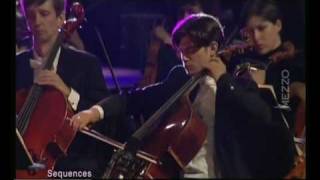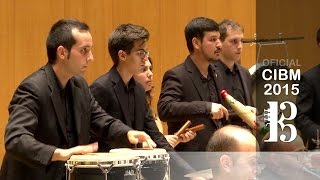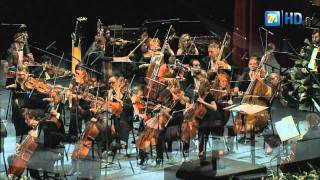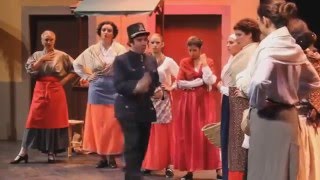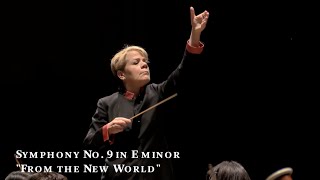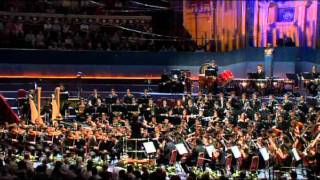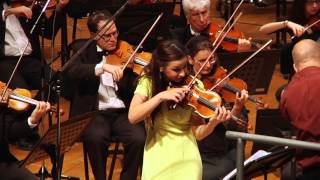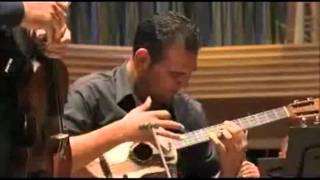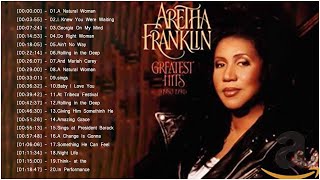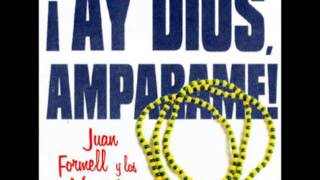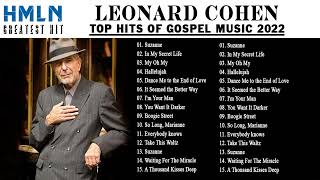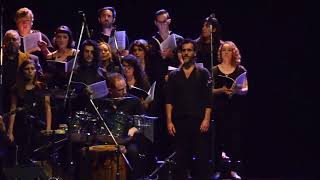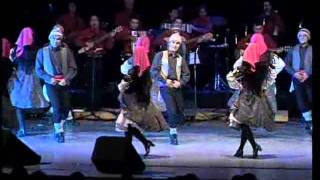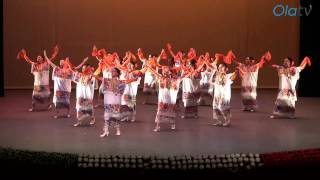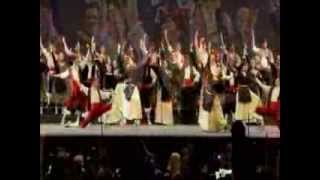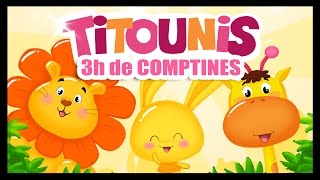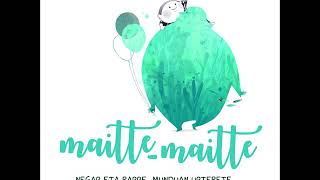On October 12 we commemorate the meeting of the West with the American Continent.
That same day, the patron saint festivities of Zaragoza are celebrated.
Recommended music videos for initiation to classical music
Heitor Villa-Lobos (1887-1959) was a Brazilian conductor and composer whose music was influenced by both Brazilian folk music and European classical music. He received some musical training from his father and by 1899, the year of his father's death, he had already begun to pursue music professionally. He performed as a café musician playing the cello, although he was also an occasional performer on guitar, clarinet and piano. As a composer, he was notoriously prolific with a legacy of works for guitar, works for piano, 17 string quartets, 9 Bachianas brasileiras, 15 Choros for various musical ensembles, 12 symphonies, 18 concertante works, 4 operas, 2 film soundtracks and numerous other works including several ballet scores.
The Bachianas Brasileiras are a collection of nine works written for different groups with a formal recollection of Bach .
The No. 5 that we present today, written for voice and eight cellos, is the best known and is performed by Amel Brahim , an Algerian soprano of Berber origin.
Victor Hugo Berrocal Montoya (1947) is a Costa Rican composer and conductor. Known as “Periquín,” Berrocal has developed an important repertoire with popular orchestras and ensembles in his country. He has also composed for concert orchestras, including solo concertos for trumpet and band, clarinet and band, or flute and band. He leads a life as a trumpet player, arranger, and composer of such famous songs as Alajuelita and symphonic works as Limón por siempre , while as in the present case, Youtube serves as a tool to remember another of his recent compositions El mambo de la big big big . The Association of Composers and Musical Authors (ACAM) awarded him the 2012 Ricardo Reca Mora Award , for a life dedicated to musical creation. (Extracted from the article by German Gerardo Delgado Coto . Source, La Nación May 12, 2012.)
Mambo is a musical rhythm and dance native to Cuba . The word " mambo " is an Afro-black term, similar to other African-American musical terms such as conga, milonga, bomba, tumba, samba, bamba, bambulá, tambo, tango, cumbé, cumbia and candombe , which denote an African, and particularly Congolese, origin. Mambo was created in the late 1930s by brothers Israel Cachao and Orestes López , when they were part of the Arcaño y sus Maravillas orchestra, by speeding up the danzón and introducing syncopation in the percussion.
Today we offer the Mambo De La Big Big Big by Víctor Hugo Berrocal performed by the Wind Orchestra Zaragoza (WOZ) conducted by maestro Frank de Vuyst .
José Pablo Moncayo (1912-1958) was a Mexican composer, who represents one of the most important musical legacies of Mexican nationalism, along with Silvestre Revueltas, Carlos Chávez and Julián Carrillo . His teachers were Candelario Huízar and Carlos Chávez , in harmony and composition respectively. During his student days he was forced to play as a pianist in cafés and radio stations to pay for his studies, until he joined the National Symphony Orchestra as a percussionist. According to Yolanda Moreno Rivas : " Moncayo 's death in 1958 ended the predominance of a style of composition, whose mark left its mark on musical creation in Mexico for more than three decades."
Huapango is Moncayo 's best-known work, so much so that in that country it has been called the second Mexican National Anthem ; it is a work inspired by the Veracruz sones that he studied during a visit to the port of Alvarado , Veracruz , and which includes melodic and rhythmic motifs from various sones among which the most obvious are "El Siquisiri", "El Balajú" and "El Gavilancito" .
Today, it is conducted by Alondra de la Parra (1980), an internationally renowned Mexican conductor who is currently the director of the Queensland Symphony Orchestra ; she is the first woman in Australia to hold a position in this entity.
Manuel Fernández Caballero ( Murcia , 1835 - Madrid , 1906) was a Spanish composer of zarzuelas of the 19th century , of which today we suggest his best-known work, Gigantes y cabezudos . He can be considered for his works as one of the master fathers of the young genre chico . The success of Los bandos de Villafrita consolidated his career, being the most performed work in Spain without falling off the billboard throughout the century. His works in general eloquently show a great mastery of orchestration and an elegant style. In addition to zarzuelas, Fernández Caballero composed secular and religious music.
Giants and Big Heads is a zarzuela in one act, three scenes, with a libretto by Miguel Echegaray y Eizaguirre and music by the maestro Manuel Fernández Caballero . It premiered at the Teatro Principal in Zaragoza , with great success, on Tuesday, November 29, 1898. The Giants and Big Heads , to which the title of the work refers, are the papier-mâché figures that parade, as a caricature, in parades, festivals and parties, a custom of medieval origin that is still very popular in towns and cities in Aragon, Catalonia, the Valencian Community and the north of the State . The action takes place in Zaragoza in the middle of the Pilar festivities.
Recommended classical music videos
Antonín Dvořák (1841-1904) was born in Nelahozeves , then Bohemia , now Czech Republic , and is considered one of the great masters of the second half of the 19th century and a leading exponent of Czech nationalism. In 1847 he entered the grammar school of his village, where he received his first musical education, showing a precocious talent. He later entered the organ school of Prague, developing as a professional violist; he played the viola in the Orchestra of the Bohemian Provisional Theatre , which was directed from 1866 by Bedřich Smetana .
He visited England on nine occasions, usually to present and conduct his own music, where he received important prizes, as well as in Prague and Berlin. From 1892 to 1895 Dvořák was director of the National Conservatory in New York ; from his arrival in the USA in 1892 Dvořák showed a great interest in Native American music, as evidenced by the New World Symphony we offer today. In April 1895 he left the United States and returned permanently to his homeland, from which he rarely left. As soon as he arrived in Prague he resumed his work as a teacher at the Conservatory . In the last years of his life the great composer continued to receive all kinds of honours and recognition.
Throughout his life he wrote music for piano, violin and piano, trios, quartets, quintets, a sextet, two series of Slavonic dances, serenades, suites, overtures, three rhapsodies, five symphonic poems, nine symphonies, several concertos, 100 songs and vocal duets and several operas.
Symphony No. 9 in E minor, Op. 95 (1893), also known as the New World Symphony , was composed by Antonín Dvořák in 1893, shortly after the composer's arrival in the USA , and is his best-known symphony. This symphony is closely related to its title; the problem is that it is often not translated correctly. The literal translation is actually " Symphony from the New World ," a reference that Dvořák makes to ancient Europe through a combination of melodies and influences from native music, such as negro spirituals, with themes from his native Bohemia , all of them treated with the resources of modern orchestration and reflected in the last chord of the symphony, which fades to piano, thus making reference to the title and moving away from old Europe .
The work is articulated in four movements: I (0´4´´) ADAGIO- ALLEGRO MOLTO .-. II (9´00´´) LARGO .-. III (20´02´´) SCHERZO: MOLTO VIVACE-POCO SOSTENUTO .-. IV (26´50´´) ALLEGRO CON FUOCO and today it is offered to us by the Peabody Symphony Orchestra conducted by maestro Marin Alsop (1956), American violinist and conductor, currently principal conductor of the Baltimore Symphony Orchestra , which has made her the first woman to occupy a position of this level in the USA ; She is also principal guest conductor of the São Paulo State Symphony Orchestra .
Leonard Bernstein (1918 – 1990) was an American composer, pianist, and conductor. He was the first American -born conductor to achieve worldwide fame, best known for his direction of the New York Philharmonic Orchestra , his television Concerts for Young People from 1958 to 1972, and his many compositions, including West Side Story (1957) and Candide . He was also a pivotal figure in the modern revival of the music of Gustav Mahler , the composer he most passionately cared about. As a composer, he wrote piano music, chamber music, choral music, church music, numerous stage works for ballet, film, opera, and musicals, as well as numerous orchestral works.
West Side Story is a musical with a book by Arthur Laurents , music by Leonard Bernstein , and lyrics by Stephen Sondheim . Loosely based on William Shakespeare 's Romeo and Juliet , the action takes place in a New York neighborhood in the mid-1950s between two youth gangs of different ethnicities: the Jets (of European roots) and the Sharks (of Puerto Rican origin). Things get complicated when Tony , a former member of the Jets , falls in love with Maria , the sister of the leader of the Sharks . The approach to the social problems of the time marked a turning point in American musical theatre. In 1961 it was brought to the big screen under the direction of Robert Wise .
Ástor Piazzolla (1921–1992) was born in Mar de Plata , Argentina. At the age of three he moved with his family to New York and at the age of thirteen he met Carlos Gardel . On his return to Argentina , he received lessons from Ginastera for six years while he regularly attended the Café Germinal where tango music was the daily bread. He was part of various groups, where purists considered his innovations as the “murder of tango”. With a certain dose of pessimism he moved to Paris , where he met Nadia Boulanger who made him believe in himself and in the possible conjunction of tango with classical music . He returned to Buenos Aires with such activity that in 1973 he suffered a heart attack; despite this he continued with his compositions and recordings until 1990 when he suffered a thrombosis in Paris that he would not be able to overcome.
The Cuatro Estaciones Porteñas , also known as Estaciones Porteñas or The Four Seasons of Buenos Aires , are a set of four tango compositions written by Ástor Piazzolla , which were originally conceived and treated as different compositions rather than a suite, although Piazzolla performed them together from time to time. The pieces were composed for his quintet of violin (viola), piano, electric guitar, double bass and bandoneon. By giving the adjective porteño , referring to those born in Buenos Aires , Piazzolla gives an impression of the four seasons in Buenos Aires .
Aldemaro Romero (1928 - 2007) was a Venezuelan musician, composer, arranger and conductor. He began his musical studies with his father. In 1942, the family moved to Caracas and he began playing in nightclubs, while, at the same time, he took music classes with the Venezuelan composer Moisés Moleiro and later with Luis Alfonzo Larrain , who introduced him to his orchestra. In 1948, he created his own dance orchestra, making various contracts and recordings of different kinds in New York , Venezuela, England until in 1979 he founded the Caracas Philharmonic Orchestra. His vast musical production includes a large number of concerts for string, wind, keyboard and percussion instruments and choral groups.
The Fugue with Pajarillo by composer and pianist Aldemaro Romero is an arrangement by the author of the first movement of the Suite No. 1 for Strings ; in it he mixes popular songs and folk elements with classical forms and techniques . Says Dudamel "A pajarillo is a typical Venezuelan dance, perhaps the most famous, along with the joropo; it is like a waltz, but with the emphasis on the weak rhythm. The present piece is a pajarillo, but in combination with a complex fuga [imitation musical form]. The pajarillo that permeates the melody and rhythm gives a sense of improvisation and contrasts with the predetermined fugal form. This is what makes this piece so fascinating." (Extracted from the article published in The Phil ).
Today's performance is by violinist Alexis Cárdenas and his Ensemble accompanied by the Simón Bolívar Youth Symphony Orchestra, all of them conducted by maestro Gustavo Dudamel (1981), Venezuelan conductor, who trained within the System of Youth and Children's Orchestras of Venezuela where he began at the age of four and where he completed his studies in violin, composition and conducting. He has conducted the world's leading orchestras and is considered one of the most important conductors of today. He is currently the director of the Los Angeles Philharmonic Orchestra and the Simón Bolívar Symphony Orchestra .
Recommended music videos for all tastes
Aretha Louise Franklin (1942-2018) was an American soul, R&B, and gospel singer. She was the greatest exponent of soul and one of the greatest gospel transmitters of all time. In the mid-1960s, she established herself as a female soul star, something she used in favor of racial rights in the USA , being an influential element within the racial movement and women's liberation. In 1987, she became the first woman to enter the Rock and Roll Hall of Fame . She was selected at number one on Rolling Stone 's The 100 Greatest Singers of All Time in 2008 and was awarded 18 Grammy Awards.
Los Van Van is a Cuban orchestra founded in 1969 by its director, bassist Juan Formell . Since its founding, the orchestra has added elements taken from jazz and rock to the sound , creating a rhythmic design in the percussion and a piano figure with the bass, creating novel harmonic and melodic timbres. In the first ten years they recorded their first five albums and debuted on several international stages. Later they incorporated trombones and introduced synthesizers and keyboards with multiple sound possibilities. The use of the synthesized saxophone and electric violins attracted a lot of attention at that time. Their texts offer themes that recreate the social circumstances and Cuban daily life with the characteristic picaresque, irony and costumbrismo.
Shakira (1977) is a Colombian singer and composer who has achieved a prominent position in both Spanish and English. The daughter of a father of Lebanese descent (“Shakira” is an Arabic name meaning “full of grace”) and a Colombian mother with Catalan ancestors, at the age of eleven she won the television contest Buscando artista infantil , a prize she would repeat the following two years. At the age of 16 she was invited to participate in the Viña del Mar Song Festival and in 2010 she was the artist who closed the World Cup in South Africa . Creator of the Fundación Pies Descalzos , dedicated to helping children victims of violence in Colombia and ALAS (Latin America in Solidarity Action), she dedicates part of her time and money to charitable causes.
Leonard Cohen (1934-2016) was a Canadian poet, novelist and singer-songwriter who touched on a wide range of themes in his songs, but repeatedly focused on love and religion. In 1967 Cohen moved to the USA to begin a career as a folk singer-songwriter. His song " Suzanne " was a notable hit with Judy Collins , and for many years it was his most covered song; after which he made countless successful recordings and tours around the world. His deep, gravelly voice perfectly matches his existential pessimism. He was inducted into the Rock and Roll Hall of Fame in the USA and the Canadian Music Hall of Fame ; and in 2011 he was awarded the Prince of Asturias Award for Literature.
Recommended peculiar videos
Ariel Ramírez (1921-2010) is one of the most important figures of Argentine nativism. He studied piano and composition and at the age of 20, encouraged by Atahualpa Yupanqui , he travelled throughout the country, making contact with the different musical expressions of each region. Nine years later he made a four-year trip through Europe giving several concerts of music from his homeland; on his return to Argentina he formed a company made up of musicians and dancers with which he would tour the country for 20 years; after this stage he performed as a piano soloist in countless recitals in which he interspersed his own works.
He wrote numerous songs and works, among which the Misa Criolla stands out, which we have the opportunity to enjoy today. Its structure is made up of five movements, each of which is a replica of a traditional Argentine rhythm or musical form within the most orthodox Catholic liturgical plan. Today we offer the choreography of the first part of said Mass, performed by the Coro Nacional de Música Argentina and the Ballet Folklórico Nacional .
The Minga of Chiloé . The word minga comes from the Quechua mink'a from the time of the pre-Columbian peoples and defines the task that the inhabitants of a town had to carry out for the benefit of the community. A member of a community can call a minga to ask for help from the rest of his neighbors. On the large island of Chiloé, the “minga de tiradura de casa ” is one of the most unique and striking traditions. The objective of this activity is to move a complete house from one place to another, even across the sea and canals. Once the work is finished, as a way of thanking, the neighbor who requested the minga prepares a delicious meal, which is generally accompanied by folk music.
This music and dance video is brought to us by the Tierra Chilena folkloric group , founded in 1963 by maestro Sergio Rodríguez .
The Amalia Hernández Ballet , based at the Palacio de las Bellas Artes in Mexico City and also known as the Ballet Folklórico de México , was founded in 1952 by the dancer and choreographer Amalia Hernández . It has more than 60 of its own choreographies and has performed throughout Mexico, as well as more than 100 international tours visiting a total of 60 countries. Over the last few years, it has been a benchmark for traditional Mexican music and dance.
Amalia Hernández (1917-2000) was a Mexican dancer and choreographer, founder in 1952 of the ballet that bears her name. Amalia dedicated herself to rescuing traditional Mexican dances that had been lost over time, striving to improve their quality. In 1959, President López Mateos asked this group to become one of Mexico 's natural ambassadors.
Tomás Bretón (1850-1923) was a Spanish composer and violinist born in Salamanca. He completed his early musical studies at the Escuela de Nobles y Bellas Artes de San Eloy in his hometown. At the age of 16, he moved to Madrid , where he played in zarzuela theatre orchestras and continued his apprenticeship at the Royal Conservatory under the tutelage of maestro Emilio Arrieta , where in 1872 he received, together with Ruperto Chapí , the first prize for composition. In 1880 he received a scholarship to study abroad, residing in Rome, Milan, Vienna and Paris between 1881 and 1884. In 1901 he took over the direction of the Madrid Conservatory , a post he held until his retirement in 1921. A prolific composer in very different genres and styles, he wrote, above all, numerous zarzuelas.
La Dolores is an opera by Tomás Bretón that premiered on March 16, 1895 at the Teatro de la Zarzuela in Madrid , based on a libretto written by Tomás Bretón himself, based on the play by his friend Feliú y Codina , and making the myth of “La Dolores” even more popular.
The Jota Aragonesa is the most distinctive expression of song and dance in the Aragonese region; known and admired within and outside its borders, it has attracted foreign composers and choreographers such as Glinka , Liszt, Moiseyev ... and others who have produced some work in this genre.
The Great Jota that we offer today belongs to the opera La Dolores by Tomás Bretón.
Recommended music videos for children
Various Wikipedia articles have been used to write these texts.
The texts of Videomusicalis are written in Basque, Spanish and English.





